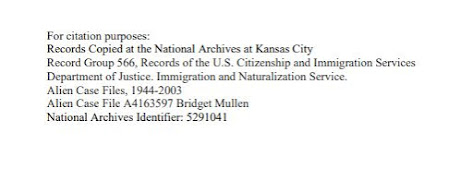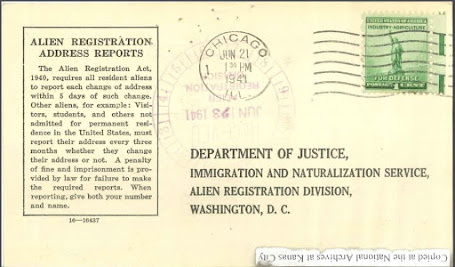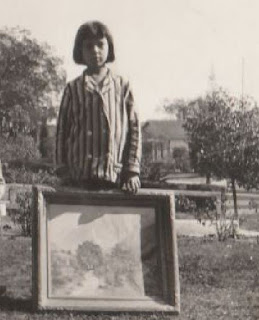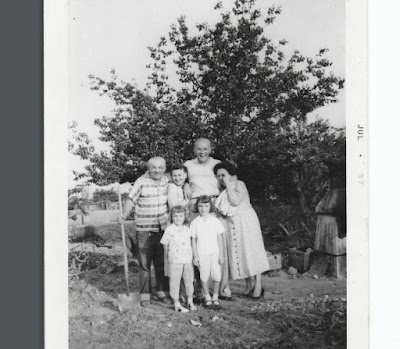My Great-Great Aunt Bridget Mullen was born in February 1888 in Milltown, Co. Galway, Ireland. I knew she had immigrated to the United States like her sister my Great-Grandmother Helen Mullen-Mason. I didn't know when but did find a Bridget Mullen born about 1888 from Milltown on a passenger list for the ship S. S. Teutonic in 1907. My great-grandmother was already here and was married with a daughter. I also found what I thought could be her on the 1910 US Census for Chicago. Bridget didn't marry but instead she became a Nun about 1911. She took the name Sister Mary Kathleen when she joined the convent.
My father enjoyed visiting with her, but I had never met her even though she lived until the age of 103. She had lived in both Chicago, Illinois and Davenport, Iowa and I hadn't visited either of those places until recently. I live in Southern California and didn't have the time to make the trip to ancestral areas until recently.
An uncle and cousin were nice to share some digitized photos with me. There were unmarked photos included in these photos. I've been using naturalization and other immigrant files to help identify people in the unmarked photos.
I assumed a nun in many of the photos was Sister Mary Kathleen Mullen. A man with Sister Mary Kathleen and my Great-Grandmother Helen was a mystery to me? Who is he? Could it have been her brother Thomas? Did Thomas come to America? I didn't know.

According to available census records for Sister Mary Kathleen she hadn't naturalized as of 1940. I searched for a naturalization record in the places she lived but never found one. My father said a relative was naturalized through an act of congress. I wondered if she was?
Since I didn't find any naturalization for her I've been searching for another record collection that might answer my questions about her. Alien files were created for US residents who weren't citizens in the 1940's. Aliens were required to register with the government. The registration documents were kept in the files along with all interactions the alien had with the INS.
When I learned about the Alien Files (aka A-Files) I searched for a record for Sister Mary Kathleen (you can read more about alien files
here). There is an index for these files on the National Archives Catalog and at Ancestry.com. I didn't find one under that name but did find one under the name Bridget Mullen, her birth name. The birth year a date for this Bridget were corrected so I figured that was her, but I wasn't completely sure.
I decided to contact the National Archives in Kansas to ask about the file and cost of getting a copy. They confirmed it was the correct file. I then ordered a copy. The cost was $27, it would have cost me $65 if I ordered it from the US Citizenship and Immigration Services (USCIS) . The archivist who responded to my request was very nice and quickly made copies of the information and sent them to me. I wasn't expecting that as the staff was only allowed in the offices for a limited amount of time because of the COVID pandemic.
Email from archive:
What was I hoping to find?
What did I hope to find in the file? I hoped to confirm that the photos were of her because a photo was required for the Alien Registration cards. I wanted to confirm I had the correct passenger list for her. I wanted to know whether she ever naturalized and how? I also didn't have any documents where my Irish immigrant family identified their parents and place of birth and hoped that information would be on these documents. I was hoping other relatives who immigrated to America may show up on these documents.
What I received
I received 25 pages of documents and photos.
Page 1
Was just a citation for the source of the information at the National Archives Kansas.
Page 2
This page immediately confirmed that Sister Mary Kathleen Mullen did naturalize because this is her naturalization certificate. The photo was a duplicate of one I received from my uncle and cousin. Two questions already answered.
Page 3
This page was a mostly blank page with just a stamp for when the INS received the naturalization documents.
Page 4
This page was a copy of Sister Mary Kathleen's naturalization petition. It confirmed her place and date of birth. There are disagreements in the records regarding the day of birth. Some records say February 1st and some 2nd. Her civil birth record in Ireland is completely wrong because the family was hiding the fact they registered her birth late and they wanted to avoid a penalty. Her church birth record is missing.
This record also confirms that the passenger list I have a copy of is the correct one for her. She did indeed arrive on the Teutonic in May of 1907.
Page 5
This page was the witnesses affidavit for naturalization. I was hoping the witnesses would include a relative. No, her witnesses were also Nuns.
Page 6
This page contained a document called Statement of Facts for Preparation of Petition. It basically contained the same information the petition did. I hadn't found this document before in my other immigrant ancestors files.
Page 7
This page was the 2nd page of the document Statement of Facts for Preparation of Petition. This is what I was hoping for not only was her place of birth confirmed again but her parents names were listed. Now I have a document Mary Kathleen provided information for that states who her parents were.
Page 8
This document was called Application to File a Petition for Naturalization. This gave the name of her employer which was Immaculate Conception Academy, Iowa.
Page 9
This document was the 2nd page of the Application to File a Petition for Naturalization. Mainly check boxes. I guess nuns weren't required to pay income tax.
Page 10
This is a Certificate of Admission card which was produced to officially verify Mary Kathleen's arrival information. I believe the cousin listed as a person she was going to meets name was actually a cousin named Martin Jennings not Timmins.
Page 11
A cover page for a call for an interview.
Page 12
A page with a notation regarding a call either in person or on the phone likely to ask her questions about her filing for naturalization. It said they called on her and she wasn't home. She was on vacation on that day in 1956. I wondered if she came out west to California to visit her sister, my Great-Grandmother Helen, who had relocated to California with her family in the 1940's? I wondered if that was when the photo was taken I'm trying to identify the unknown man in?
Page 13
A cover message letter the request for information on Sister Mary Kathleen's arrival information at Ellis Island. Oddly they asked if she still lived in New York but she never lived there. She came and joined her family who had settled early in Chicago.
Page 14
Just contained page 2 of the above letter with a typed date and nothing else.
Page 15
A document from the INS requesting information from the FBI regarding Sister Mary Kathleen.
Page 16
This page contains Sister Mary Kathleen's fingerprints. They were needed to compare with FBI files to make sure she didn't have a criminal record.
Page 17
Apparently the first set of fingerprints sent to the FBI weren't clear enough. A document explaining how to get clear fingerprints was than provided.
Page 18
This document provides the outcome of the FBI investigation. As expected Sister Mary Kathleen had no criminal record or file with them.
Page 19
Another document regarding the request for arrival information for Sister Mary Kathleen.
Page 20
Now finally an Alien Registration document. This was the postcard all non US Citizens were required to return in the early 1940's. The postmark is dated June 21st 1941. It's postmarked Chicago. Sister Mary Kathleen divided her time between Chicago where her sister and her sister's family lived, and where her order's mother house was located in Iowa.
Page 21
The opposite side of the postcard with the form information.
Page 22
A longer Alien Registration form filled out in 1940. It contains much of the same information as found on Sister Mary Kathleen petition for naturalization.
Page 23
This is page 2 of the Alien Registration long form. It confirms that Sister Mary Kathleen became a nun about 1911. It also has another of her fingerprints. I now have the first set of fingerprints of a relative.
There was a question about family members living in the United States but unfortunately it only referred to immediate family, and didn't provide any spaces to write the names of family members.

Pages 24 and 25
These pages are just two identical photos of sister Mary Kathleen Mullen for her Alien Registration.
These documents did answer many of my questions and confirmed some of my speculations. I had believed that Sister Mary Kathleen's brother Thomas also came to America. I was hoping to find his name in these documents to confirm that. I've been wondering if Thomas was the unknown man posing with his sisters in the photo I've been trying to identify the people in. The little girl in the photo is also unidentified. I will blog about what I've learned subsequently in a later post.





































































